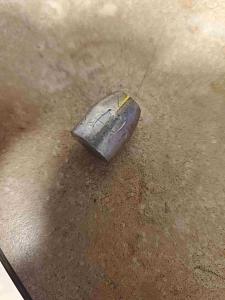I have recently began casting for .45 acp, the biggest boolit I've cast so far. I got this new NOE nlg mold. The mold is clean, no detectable defects, and it is capable of dropping a clean bullet. I am having a problem though where a solid 30% of my bullets drop with some wrinkles. The attached picture is the most common appearance of the wrinkled bullets. I don't believe it's a temperature problem. This occurs even when the mold is so hot that the sprue crumbles when I cut it. I have tried pouring slower, I have played with pouring at an angle. I have added extra tin to see if that helped. All to no avail. It is my guess that this is caused by the lead cavitating in some way as it flows into the cavity. I would really like to get cleaner pours. I cannot find any distinction in procedure between the pours that produce smooth bullets and those that produce wrinkles. Any ideas?

|
   
   
|


|



 Reply With Quote
Reply With Quote
























